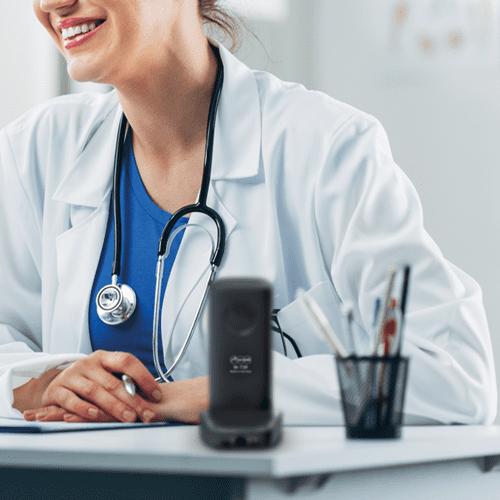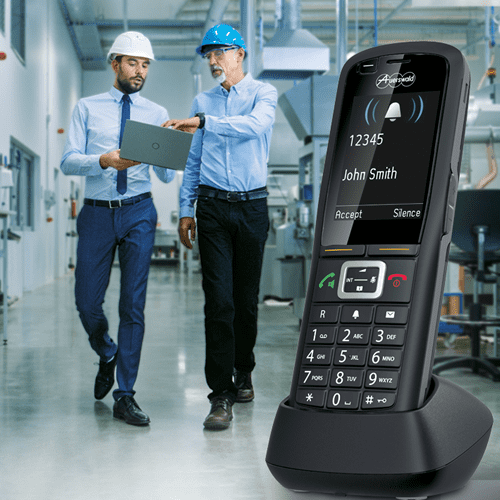
In most EU countries, those systems are required by law for medical facilities as well as for old people‘s and nursing homes. Typically, these systems are connected to a telephone system with a DECT extension for the notification of nursing staff. Here, many facilities still need to catch up or modernise.

But such systems are also being used more and more in the industry. In these environments, it is e.g. a matter of protecting lone workers (triggering an alarm or localising in an emergency) or machine alarms. In addition, more and more public institutions such as authorities or schools are using such systems for alarming or fire protection.
There are essentially three function blocks. (Picture 1) The typical path of an alarm starts with triggering via push buttons (permanently installed or via radio), pull cords, door contacts or other installations. Especially in care facilities, these are connected to a light call system that additionally reports the alarm visually. Of course, systems such as a fire alarm system can also be easily integrated. The new alarm button on our COMfortel M-710 and M-730 supports this function and can be integrated into various scenarios.
The nurse call system usually passes the alarm on to the alarm server via an ESPA interface. This is an important part of the chain, as events will be logged here, feedback can be evaluated and renewed alarm messages can be generated in an emergency.
In addition to visualisation via the lighting system, staff are now typically alerted via the DECT devices of a telephone system, if desired also via wired desktop devices. It is important to have good radio coverage of the entire building and outdoor area so that the relevant people can always be reliably reached.
For the transmission of the alarm from the lighting system to the alarm server, the ESPA interface has established itself as a standard.
The alarm servers on the other hand communicate with the Auerswald communication system via the new alarm messaging interface using MQTT and / or SIP.
Internally, the terminals are also connected via SIP; for mobile terminals, of course, there is DECT for the air interface.
What is exciting, however, is how the transmission of messages between the alarm server and the communication system takes place with the new messaging interface.
Based on the priority (e.g., room call, fire alarm, facility message) the messaging at the DECT handsets is executed with different ringing tones and visually using graphical and textual elements in the display, even during an ongoing call. This means, a user can be alerted in nearly every state of the terminal.
Additionally, other users can be informed which user has acknowledged the alarm. If there is no acknowledgement the alarm will be forwarded to other users.
Furthermore, an option can be activated for an alarm (e.g., fire incident) that the alerted personnel must send an acknowledgement. And, even more, there is the possibility for the personnel to setup a direct call to the person who has initiated the alarm (e.g., at a room call with the inhabitant).
Picture 2 shows different alarm priorities: from silent alarm via info message up to an active message with situationdependent symbols.
Marked blue: softkeys for the acknowledgement and direct call to the room.
There are various possibilities for alerting and initiating of matching actions directly from the terminal.

Picture 2: different priorities at DECT handsets
Picture 3 shows the presentation of the text messages in the display of the desktop phones from the COMfortel D series: at COMfortel D-110 / 210 it appears in the complete display, at COMfortel D-400 / 600 it is shown as a banner including switchable notify tone.

Picture 3: Presentation at desktop phones of the D series
Alarming is attractive especially due to the link-up to communication systems because in the case of Auerswald they undertake many functions additionally – from calling of the next patient to emergency information via the door phone unit.
Do not leave patients or visitors standing in front of the door outside normal opening hours. When using a video door phone, the image can be displayed on the display of a desktop telephone, e.g., a COMfortel D-400, and the visitor in front of the door can be spoken to. This saves time because the nursing staff does not have to walk to the entrance every time.
Alarming is a very attractive market – especially in conjunction with Auerswald communication systems. You would like to test it?
No problem: since firmware version 2.44 of the DECT bases WS-500S / WS-500M a free license for one handset is included.
The alarm servers of our partners have implemented the AML interface of the Auerswald COMfortel M series and are certified.